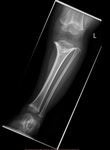Purpose
Premature growth plate fusion and associated limb length discrepancy is a cause of morbidity in the paediatric population. Appearances and causes are variable and presentation is often temporally remote to the initial insult. Children frequently present to the orthopaedic service with leg length discrepancy. The purpose of this study was to review the causes of non-traumatic premature fusion of growth plates in children to and identity the most common patterns of injury on plain film radiographs.
Bone growth and expansion occurs almost exclusively at the...
Methods and materials
A retrospective review was carried out using the hospital digital imaging PACS system using the text search function of radiology reports. A list of all radiology reports for the past 12 years, 2007 to 2019 inclusive, which included text phrases associated with physeal arrest was generated. Each case was reviewed by of two 3rd year radiology SpRs and any cases where there was a disagreement was reviewed by a consultant paediatric radiologist. Retrospective analysis of all prior and subsequent imaging, including all request and reporting...
Results
19 patients with non-traumatic premature growth plate fusion involving a total of 49 growth plates were identified.
7 patients demonstrated premature fusion localized to a single site, of which:
4 (57%) had a history of osteomyelitis, 2 (29%) had avascular necrosis of the femoral head (Perthes disease) and in one case, the cause could not be determined.
In 12 patients more than one growth plate was involved:
Of these, 6 (50%) had a history of sepsis (5 meningococcal, 1 pneumococcal), 3 (25%) had a history...
Conclusion
Non-traumatic premature physeal bony bridging in children has a wide variety of aetiologies with infection, avascular necrosis and sickle cell disease being the most common in our cohort. Systemic conditions such as meningococcal sepsis or Sickle cell disease are the most common causes of multifocal involvement. The appearances are variable and, especially when multifocal, can mimic other conditions such as skeletal dysplasia.
Personal information and conflict of interest
C. E. O'brien; Dublin/IE - nothing to disclose C. Ní Leidhin; Dublin/IE - nothing to disclose R. Hayes; Dublin/IE - nothing to disclose J. Duignan; Dublin/IE - nothing to disclose A. C. O'brien; Dublin/IE - nothing to disclose
References
(1)Patterns of Premature Physeal Arrest: MR Imaging of 111 Children. Kirsten Ecklund and Diego Jaramillo. www.ajronline.org/doi/full/10.2214/ajr.178.4.1780967 American Journal of Roentgenology. 2002;178: 967-972. 10.2214/ajr.178.4.1780967
(2)Imaging of Pediatric Growth Plate Disturbances, Jie C. Nguyen, B. Keegan Markhardt, Arnold C. Merrow, and Jerry R. Dwek, RadioGraphics 2017 37:6, 1791-1812
(3)Khoshhal KI, Kiefer GN. Physeal bridge resection. J Am Acad Orthop Surg 2005;13(1):47–58.
(4)Healing of large surgical defects of the epiphysial plate. An experimental study. (PMID:8131347) Clinical Orthopaedics and Related Research [01 Mar 1994(300):264-268]
(5)Orthopaedic implications of physeal arrest...




